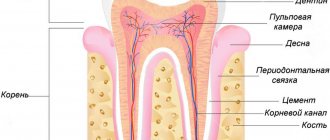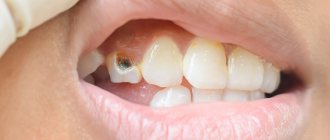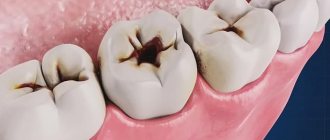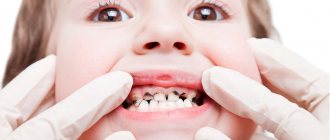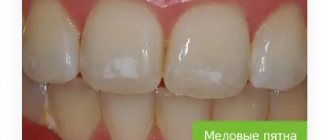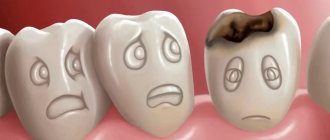Author of the article:
Soldatova Lyudmila Nikolaevna
Candidate of Medical Sciences, Professor of the Department of Clinical Dentistry of the St. Petersburg Medical and Social Institute, Chief Physician of the Alfa-Dent Dental Clinic, St. Petersburg
Medium caries is a stage of the carious process that occurs after the initial one and precedes the deep one. It is characterized not only by the destruction of enamel, but also by disruption of the dentin structure. Often the disease is practically asymptomatic, so the patient cannot independently identify the presence of this disease. The only method of self-diagnosis is to pay attention to changes in the appearance of the tooth when examining the oral cavity in a mirror (presence of holes) or to the appearance of sensitivity while eating.
If you look at a photo of average caries, you will notice pronounced changes in the structure and color of the affected area. Most often, the disease develops on the contact (chewing) part of the tooth. In the photo you can see dark brown or almost black spots, small or large holes, which can be located on any part of the tooth. These holes are a carious cavity in which dentin gradually softens and food debris accumulates.
With chronic average caries, the destruction of the enamel and dentinal layer occurs faster - carious cavities can appear as early as five months after the initial changes in the tooth enamel. Most often, young children suffer from the chronic form of the disease.
Causes of the disease
There are several factors that lead to the occurrence of this disease:
- Cariogenic microflora of the oral cavity.
- Increased carbohydrate content in the diet.
- Reduced resistance of hard tissues.
- Lack of oral hygiene.
- Malocclusion.
- Genetic predisposition to the disease.
- Plaque or tartar.
- Weakening of the immune system.
- Bleeding gums.
- Changes in the composition of saliva.
- Lack of calcium.
- Fluoride deficiency.
- Poor diet.
- Lack of vitamins.
- Abuse of carbonated drinks.
The main cause of average caries is late diagnosis of the disease at an early stage.
Deep dental caries: signs, stages of treatment
Statistics show that most often patients come to dentists when dental caries has developed to a deep stage and the tooth begins to hurt badly. Moreover, pain can occur on its own, without external influence.
A tooth affected by deep caries is most often severely damaged - it has a deep cavity, almost reaching the root part. This is the reason for severe pain, because the disease has reached the part of the tooth in which the nerve endings are concentrated. If treatment for deep caries is not started immediately, there is a high probability of complications such as pulpitis and periodontitis.
Symptoms of the disease
The disease can exclusively affect the upper layers of dentin. The process of development of medium-sized caries is accompanied by destruction of the enamel layer and a violation of the boundary between enamel and dentin. As a result, patients complain of the following unpleasant sensations:
- The presence of a carious cavity, which is easily detected using the tongue. In some cases, it may have sharp edges and cause injury.
- Food getting into the carious hole if it is located on the contact part of the tooth.
- Short-term painful sensations from exposure to hot or cold food, liquids, from the chewing process and from mechanical impact on the diseased tooth. Once the cause of the pain is eliminated, the unpleasant symptoms quickly disappear.
Average dental caries: what is it?
In total, experts distinguish four stages of the disease: initial, superficial, intermediate (dentine caries), deep caries. Each stage is characterized by its own depth of damage. For example, one cannot say that a person has superficial average caries, since this would be a gross mistake in terms of classifying the disease. On the other hand, if left untreated, a milder stage will at some point turn into a more severe one. If during superficial caries only the enamel structure is destroyed, then medium caries affects the dentin layer.
Medium and deep caries differ in that at the stage of deep damage the inflammatory process affects the dental pulp. The middle stage is not the easiest. However, it has more pronounced (compared to superficial and initial) symptoms, is quite easily diagnosed, and with timely dental care, the patient in the vast majority of cases can avoid serious consequences and save the tooth and its pulp. Experts distinguish two types of average caries.
Types of average caries
✔
Chronic average caries.
It lasts a long time and may not have pronounced symptoms.
With this form, a fairly wide brown carious hollow with hard walls is formed. ✔
Acute medium caries.
A rapidly developing form in which a small hole with sharp and brittle edges appears, which is filled with loose dentin.
Diagnosis of the disease
To prescribe effective treatment for the disease and exclude the presence of other diseases, it is necessary to diagnose secondary caries, which is carried out by the treating dentist.
In most cases, an experienced specialist only needs an instrumental examination to make a diagnosis. It is carried out using a probe and a mirror. As a result of the examination, a carious cavity is discovered, inside of which there is softened dentin. Mild pain is present only when probing the bottom of the cavity, since there are exposed nerve endings there. The walls of the carious cavity are insensitive.
During diagnosis, the doctor pays attention to the following factors:
- Density of the cavity bottom.
- Localization of the carious hole.
- The color of the damaged tooth.
- The presence and nature of pain in the patient during the study.
A soft bottom indicates moderate dental caries, and its density may indicate the presence of a wedge-shaped defect. The tooth becomes gray if the patient has developed chronic periodontitis. The short duration of painful sensations indicates superficial caries, and if the pain lasts longer than ten seconds, the disease has acquired a deep form.
If the affected area is in a hard-to-reach place, the doctor may prescribe an X-ray examination for the patient. In some cases, the dentist recommends undergoing electroodontic diagnostics or thermal testing.
Stages of caries
Administrator
|
08/26/2021
|
You need to know this
Caries is a sluggish process that includes 4 stages of development - from a superficial spot to a deep carious “hole”. The disease progresses over months, and with strong immunity it drags on for several years.
There are 3 methods for determining the stage of caries: visual examination, x-ray diagnostics and the use of caries markers.
Initial stage (macula cariosa)
The carious stain stage begins due to the loss of minerals - calcium salts and fluoride compounds. The process is called demineralization. In areas of the enamel where mineral loss has occurred, a white spot is formed, the color resembling chalk.
At the chalky spot stage, you will not even realize that tooth decay is already with you, since there are no symptoms. The problem is discovered only during a routine examination by a dentist.
This is the only reversible form of the disease; its development is easy to stop. For this purpose, the method of deep fluoridation is used - saturating the enamel with valuable microelements.
If you ignore the problem, over time the tooth surface loses its shine, and organic dyes penetrate into the affected area. The carious spot becomes yellow or brown.
It is important to distinguish initial caries from fluorosis and hypoplasia. With fluorosis, identical spots of identical shape and color are formed. Hypoplasia is characterized by glassy lesions that are evenly distributed around the tooth.
To accurately determine the diagnosis, an indicator solution is used - a caries marker. When exposed to liquid, the carious spot turns pink or blue, while foci of non-carious origin remain the same.
Superficial caries (caries superficialis)
At the next stage, the integrity of the enamel layer is compromised, and the tooth surface becomes rough. The carious area is more noticeable during visual inspection. A sharp pain reaction appears when eating cold and hot food, and sensitivity to chemical agents - sweet, sour, salty. There may be discomfort while brushing your teeth.
The pain is short-term and goes away immediately after the stimulus is removed. Most often, the carious lesion is localized in the gingival zone on the front teeth (neck of the tooth) or in the tubercles on the lateral chewing molars.
At this stage, the enamel is no longer able to repair itself, and irreversible changes occur in its structure. Only a dentist can help. The doctor cleans out carious cells with a drill, neutralizes pathogenic microflora with an antiseptic and installs a filling.
A non-invasive method of treating superficial caries is infiltration with Icon liquid filling. The method allows you to restore the rough surface of a tooth without drilling with a drill.
Middle stage (caries media)
At the third stage, caries penetrates deeper, affecting not only the enamel, but also dentin - the inner bone tissue of the tooth. A noticeable carious cavity is formed, where food particles constantly fall, causing acute pain. In this case, the pain reaction lasts several minutes.
Dentinal microtubules expand, cariogenic bacteria (Streptococcus mutans, Streptococcus sanguis) penetrate there and their metabolic products - toxins and acids - accumulate. Hard dental tissues affected by caries soften and settle at the bottom of the cavity.
The dentist determines the depth of the defect using viewing instruments - a probe and a mirror. When probing, be prepared for sharp pain.
Average caries near the gingival margin is visually similar to a wedge-shaped enamel defect. However, the second disease is characterized by a smooth surface and absence of pain.
Deep stage (caries profunda)
A deep carious “hollow” is formed with a narrow entrance and a wide base. Dentin is destroyed, microbes reach the peripulpal dental tissues. These are the tissues that are located on the border with the pulp chamber of the tooth, where the nerve endings and small vessels are located. At the bottom of the carious cavity, softened dentin accumulates, devoid of “building materials” - calcium salts.
Severe pain appears from mechanical, chemical and temperature stimuli. The tooth is so damaged that it is difficult and uncomfortable for a person to chew food.
Deep caries requires immediate treatment, otherwise bacteria will penetrate into the pulp and inflammation of the dental nerve will begin (pulpitis). The disease is accompanied by excruciating radiating pain that is random in nature.
To treat an advanced form of caries, the doctor has to drill out the infected tissue for a long time and carefully. An insulating gasket must be installed at the bottom of the cavity and only then the defect is filled with filling material.
Stages of caries of primary teeth
Caries of primary teeth in children progresses faster; the initial stage literally turns into an advanced form in 2-3 months. In addition, in 70% of cases, not one, but several carious lesions occur at once.
Why do children's teeth decay so quickly?
- the enamel of primary teeth is thin and porous;
- the child’s immunity is not yet strong, so it is difficult for the body to fight carious infection;
- Most parents ignore the problem, believing that it is not necessary to treat baby teeth.
Childhood caries is complicated by a background of reduced immunity, including due to a cold or hypothermia. If a child complains of pain in the mouth, refuses to eat and becomes capricious, you should carefully examine his oral cavity, or better yet, consult a dentist.
Initial caries of baby teeth is treated with a cheap and painless method of silvering. At later stages, it is necessary to place a photopolymer filling. But instead of a drill, they use hand tools for dissection.
Tags:
dentistry
|
Previous post
Next post
Lenochka, Ekaterinburg
|
29.09.2021
Caries in children is a problem!
Administrator
|
29.09.2021
Yes Elena, we agree with you, caries in children is a problem
Nikolay, Ekaterinburg
|
26.10.2021
Treatment of caries is such a painful process! It's better not to delay
Administrator
|
26.10.2021
Nikolay, you are absolutely right - at least once every six months, you need to be examined by your doctor. Better, of course, more often!
Write a comment
Treatment of average caries
After diagnosis, it is necessary to urgently treat the disease to prevent the process from spreading to the deep layers of dentin. Otherwise, inflammation of the pulp may occur.
Treatment is carried out by preparing the damaged areas. It goes through several stages:
- The overhanging edges of the carious hole are carefully removed.
- Dentin, which has undergone a process of softening and pigmentation, is removed from the cavity.
- The bottom and walls of the damaged tooth are cleaned of the remains of destroyed tissue.
- A cavity is formed for subsequent filling.
During each stage, the dentist uses a specific type of bur, which differs in the shape and diameter of the tip. Preparation is carried out in bright light. At the end of this process, the cleaned cavity is treated with antiseptics, degreased, and then thoroughly dried.
The walls and bottom of the hole are coated with a special “glue”, and then the cavity is filled with filling material, which undergoes a curing process using chemical or light radiation.
The finished filling is corrected using diamond burs, as well as using various grinding discs, pastes and brushes. Correction can be made several times. The purpose of this procedure is to achieve maximum comfort in the patient when clenching the jaw. The restored surface should not cause even the slightest discomfort.
Treatment of caries in the spot stage
Treatment of caries in the spot stage will be as simple and painless as possible for the patient. It is carried out without the use of a drill, using the remineralization method. The essence of this method is to treat dental surfaces with special solutions that contain substances that strengthen and restore tooth enamel: calcium, magnesium and potassium.
- The remineralization procedure is carried out according to the following scheme:
- Professional teeth cleaning to remove plaque is carried out;
- Teeth with caries are dried and polished;
- The surface of infected teeth is covered with a solution of a remineralizing drug.
Naturally, one procedure for restoring enamel will not be enough, and therefore a full course of tooth remineralization when treating caries in the stain stage involves 10-12 treatment sessions.
Prognosis and consequences of the disease
Treatment of this disease, if the dentist has sufficient experience, is successful - all unpleasant sensations in the sealed cavity completely disappear, and the tooth again acquires aesthetic appeal. If an untreated area remains under the filling, the disease will progress further. For this reason, it is necessary to carefully consider the choice of clinic and attending physician.
If average caries is not treated in a timely manner, the disease will enter an advanced stage, which is fraught with severe pain, the development of pulpitis and periodontitis, and then tooth loss.
Dental caries in the stain stage: signs, treatment features
Dental caries in the stain stage is difficult to diagnose without the use of specialized tools. A person most often does not even suspect that his teeth are affected by caries, because at this stage of the development of the disease there are no pronounced external signs and pain. There is also no increased sensitivity of teeth to external irritants: hot/cold food, sweet or sour foods.
When caries is in the stain stage, the tooth enamel loses its pleasant and healthy shine, white spots appear on the surface of the tooth, which can spread to “neighbors” in the dentition. You can identify caries in the spot stage during an examination at the dentist's office. To detect the disease, a specialist will use a special solution.
The solution is applied to pre-dried dental surfaces and if there is caries, blue and clearly visible spots will appear.
Disease prevention
After each meal, food particles remain in the oral cavity, which contribute to the development of decay processes and create a favorable environment for bacteria. To prevent the spread of harmful microorganisms, it is necessary to brush your teeth regularly.
If a person has a tendency to develop the disease, the dentist prescribes special toothpastes that can reduce the risk of the disease. Thus, we recommend ASEPTA PLUS REMINERALIZATION paste, which strengthens the enamel and prevents caries on teeth.
Technologies for treating superficial caries
When treating superficial dental caries, the remineralization procedure will not be enough. The treatment process will require the following actions:
1. Professional teeth cleaning to remove plaque.
2. The tooth is isolated with a rubber dam (a scarf made of dense latex). This is necessary to completely prevent moisture from entering the tooth being treated. Even a small amount of moisture can affect the strength and durability of the filling!
3. Removal of enamel destroyed by caries. This manipulation is carried out using a drill. But there is no need to be afraid: firstly, local anesthesia is required before drilling teeth, and secondly, when treating superficial caries, a small amount of tooth tissue is removed.
4. Tooth enamel is treated with a special acid, which improves the quality of adhesion of the filling to natural tissues. After etching the tooth in the treatment of superficial caries, the acid is washed off.
5. Next, the doctor applies a special glue to the tooth, which will ensure that the filling is firmly secured and then proceeds directly to the filling. Using a photopolymer filling material, the specialist will form the missing part of the tooth. This is done in stages, and each layer of filling material is illuminated with a special lamp for high-quality hardening.
The treatment of superficial caries is completed by grinding and sealing the installed filling. These procedures allow you to give the filling its final shape and aesthetic appearance, making it perfectly smooth.
Clinical researches
Clinical studies have proven that regular use of professional toothpaste ASEPTA REMINERALIZATION improved the condition of the enamel by 64% and reduced tooth sensitivity by 66% after just 4 weeks.
Sources:
- Report on the determination/confirmation of the preventive properties of personal oral hygiene products “ASEPTA PLUS” Remineralization doctor-researcher A.A. Leontyev, head Department of Preventive Dentistry, Doctor of Medical Sciences, Professor S.B. Ulitovsky First St. Petersburg State Medical University named after. acad. I.P. Pavlova, Department of Preventive Dentistry
- Clinical experience in using the Asepta series of products Fuchs Elena Ivanovna Assistant of the Department of Therapeutic and Pediatric Dentistry State Budgetary Educational Institution of Higher Professional Education Ryazan State Medical University named after Academician I.P. Pavlova of the Ministry of Health and Social Development of the Russian Federation (GBOU VPO RyazSMU Ministry of Health and Social Development of Russia)
- Evaluation of the clinical effectiveness of a combined drug of local etiotropic action in the treatment of inflammatory periodontal diseases (E.L. Kalichkina, E.A. Tyo, Z.Z. Abubakarova) E.L. Kalichkina, candidate of medical sciences, assistant of the department of therapeutic dentistry, Kemerovo State Medical Academy of Roszdrav, Kemerovo E.A. Tyo, MD, professor, head of the department of therapeutic dentistry, Kemerovo State Medical Academy of Roszdrav, Kemerovo Abubakarova, assistant of the department of therapeutic dentistry, Kemerovo State Medical Academy of Roszdrav, Kemerovo GOU HPE Kemerovo State Medical Academy of Roszdrav , Kemerovo
How is deep caries treated?
Treatment of deep caries begins with diagnosis; a photograph of the tooth is necessarily taken, which will allow you to choose the optimal and effective treatment regimen. It is no longer possible to do without anesthesia when treating the disease at this stage, otherwise, any actions of the doctor will cause severe pain to the patient.
In addition, treatment of deep caries will involve two visits to the clinic. This is explained by severe tooth destruction, resulting in too thin a layer of healthy tissue remaining between the dentin and the pulp (nerve of the tooth), which does not eliminate the risk of pulp infection. To prevent the development of pulpitis after filling a tooth during the treatment of deep caries, the first visit to the dentist involves removing tissue destroyed by caries, antiseptic treatment of the tooth cavity and installing a temporary filling. Then there is a break in treatment for several days. If during this time the tooth does not begin to hurt, a permanent filling is placed on the tooth during the second visit to the dentist.
IMPORTANT: If deep caries has led to tooth destruction of more than 50%, the dentist will advise you to restore it by installing a crown or inlay. And this will be the right decision, because from the high load that inevitably occurs when chewing food, the filling can fall out or break, and break along with part of the tooth. If the root of the tooth is injured, it will no longer be saved!
Permanent and temporary fillings
Depending on the clinical picture, caries treatment is carried out in one or two stages. If the wall between the cavity and the pulp is too thin, it is advisable to carry out two-stage treatment.
Treatment of moderate caries with Asteria filling material.
If the doctor is not sure that the pulp will not be involved in the development of pathology, at the first visit he installs a temporary filling. If the toothache does not occur within a few days, it can be removed and replaced with a permanent one. If pain occurs, the tooth will have to be depulped. In such cases, it is not recommended to immediately install a permanent filling, since it will be difficult to remove.
In other situations, treatment is carried out in one stage, with a permanent filling immediately installed. In modern clinics, preference is given to composite materials that harden under the influence of a special lamp. Such fillings allow for high-quality dental restoration, since they are identical in appearance to enamel. Photopolymer materials are very durable; such a tooth will not remind of itself for many years.
The use of photopolymer fillings in children is limited. The material is stronger than baby teeth, so they often chip. With the natural wear of teeth, such a filling begins to protrude beyond the enamel, which can ruin the bite. Composite materials are used only for the restoration of children's incisors, since other materials will not adhere to them.
If the cavity is too large, ceramic inlays are an alternative to fillings. They are made in a dental laboratory using individual impressions. This inlay is more reliable than a large filling. The price of an inlay is higher than a filling, but often this is the optimal solution.
With proper, timely treatment, the prognosis for moderate caries is favorable. The restored tooth is no different from the rest and copes perfectly with the chewing function.
If you treat a tooth with an experienced doctor in Moscow, the risk of caries recurrence is minimal. Radical removal of softened dentin and careful treatment of the cavity do not leave the disease a single chance.
Etiology of acute and chronic caries
Dental caries is not an independent disease. Speaking about the factors that provoke their development, experts mention the state of the body as a whole, gastrointestinal diseases, general and local immunity, diet (amount of carbohydrates consumed)... But that’s not all - the following also play a role:
- Microflora of the oral cavity;
- Intensity and quality of salivation;
- The amount of fluoride that enters the body;
- Environmental component.
At the same time, the main factors for the development of caries remain unchanged:
- Susceptibility of the tooth surface to acids;
- Presence of cariogenic microorganisms in the oral cavity;
- The presence of microorganisms in the oral cavity that prevent the development of caries;
- Regularity and quality of hygiene measures.
Today, there are more than 400 theories about the causes of caries... But almost all of them are based on the fact that its occurrence is provoked by excessive accumulations of dental plaque. It occurs due to poor and irregular oral hygiene, especially in the fissures and on the lateral surfaces of the teeth. In these areas, it is not naturally removed by chewing and is difficult to remove during brushing due to poor access. In itself, it is an ideal environment for the development of pathogenic (in particular, streptococcal flora). As a result, it sticks to the tooth surface and becomes compacted due to the action of mineral salts contained in saliva, and then dental plaque is formed.
The bacteria that live in it produce lactic acid, under the influence of which the enamel loses salts and minerals (the process of demineralization). This is the first stage of the development of the disease. Another initiating factor for demineralization is a branched glucose polymer, which streptococci produce from sucrose. It is for this reason that the development of pathological processes is associated with the consumption of foods containing simple carbohydrates.
The rate of development of acute caries is determined by the individual characteristics of the body. In most cases, the ability to resist cariogenic bacteria is low, so the pathological process develops quickly. However, if immunity is high enough and there are no concomitant pathologies, the process slows down. The composition of saliva also plays a role: if the ratio of mineral salts in it is disturbed, the risk and rate of development of carious processes is higher due to the deterioration of its antibacterial characteristics. Don’t forget about the environmental component and the quality of drinking water, because they also affect overall immunity.
Types of acute caries
Acute caries is divided into three types:
Acute superficial (or initial)
With this type, patients either do not show any complaints at all, or talk about tooth reactions to chemical irritants - sweet, sour and salty, less often a slight reaction to cold occurs. The reason is the destruction of the enamel, a violation of its mineral composition. A carious spot is visible, which has already passed into the stage of a shallow hole that has not yet passed beyond the boundaries of the enamel. An x-ray shows a superficial enamel defect.
Spicy medium
This type of caries is characterized by complaints of local short-term pain associated with exposure to a temperature or chemical irritant. The enamel has already been destroyed, further degenerative processes occur in the deeper layer of the tooth, dentin. You can see a hole that has destroyed all the enamel and moved to the border with dentin or to the dentin itself, this can be seen on the x-ray.
Spicy deep
The most neglected option. Characterized by pain in response to chemical, thermal and mechanical stimulation. Upon examination, softened dentin is noticeable, which lines the resulting carious hole. The x-ray shows a significant defect in which the dentin layer is separated from the tooth cavity.
What stages of caries treatment are present in case of complications.
Root canal cleaning becomes necessary if the carious process has spread deep enough and the nerve in the tooth dies from infection. The center of the tooth's canal, including the nerve tissue and blood vessels (pulp), is removed along with the decayed areas of the tooth. The roots of the tooth are sealed with a sealing material and only after this is it possible to install a filling.
Crown
used in treatment if caries is extensive and the tooth structure is severely damaged, which can lead to weakening of the tooth and loss of chewing functions. Crowns are used when there is a large amount of composite material (filling) on a tooth. When filling a large area, the risk of the filling breaking or falling out completely is too great. Large fillings on teeth also increase the risk of cracks and chipping of the tooth itself under chewing loads. When installing a large filling, for its reliability and durability, the dentist may recommend installing a fiberglass, anchor or titanium pin. The pin is installed in the already treated and sealed root canal before installing the filling. Tooth pinning is mandatory in case of significant tooth destruction and fracture of its walls.
To install a crown, the tooth is treated for caries and ground down, after which impressions are taken, from which a crown is made in a dental laboratory. Teeth crowns can be made of metal, ceramics or metal-ceramics.
Timely treatment often saves the tooth and gives it a “second life.” Early treatment is less painful and less expensive than treating an extensive infection such as pulpitis or periodontitis. The Estet dental clinic uses high-quality anesthetics to completely avoid pain and discomfort during treatment. Dentistry Esthete recommends visiting the dentist at least once every six months for preventive examinations in order to avoid serious dental diseases.

